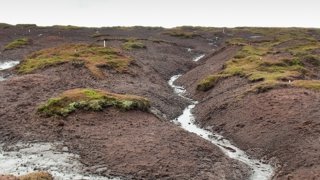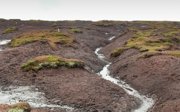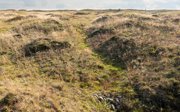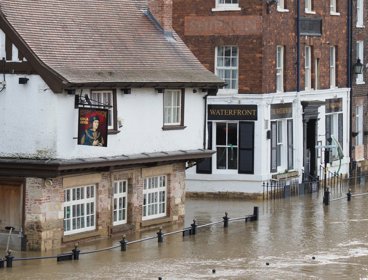By Martin Evans, University of Manchester
My personal interest in peatlands began with a focus on their geomorphology. Upland peatlands, although rarely recognised as such, are amongst the most active geomorphological systems in the UK. Working on field sites in the Peak District required close collaboration with landowners and managers. Working closely with organisations such as Moors for the future and the National Trust I learnt about extensive efforts to restore eroding peatlands and my interests broadened to think about peatland restoration and the impact of both erosion and restoration on the ways in which peatland systems interact with wider society. The role of peatlands in carbon capture, flood mitigation and in the storage and release of pollutants were all part of this story and led to collaborations with the Environment Agency, water companies and a wide range of conservation bodies. Over time the relationship with partners deepened. We moved from partnership to co-production of research so that for many projects the underlying question has direct relevance for immediate challenges facing practitioners. This had significant benefits for all parties and was hugely rewarding, but like all relationships there are ups and downs and it requires work.
Making a start
As an early career researcher it can be challenging to find the niche where your work is valued and makes a difference. Networking is important. Senior colleagues may have contacts they can share and if there are industry or practitioner conferences in your area make the time to attend them. Direct approaches are often welcome as well. You may be surprised at the pent-up demand for the knowledge you can share and interesting invitations and opportunities can follow.
The benefits
The benefits in terms of a direct route for your research to impact the wider world are obvious, but there are other very significant positives that emerge from this way of working.
Firstly, academics have much to learn from practitioners both from their in-depth knowledge of the systems they work with but also from their expertise in the application of knowledge in their sphere. Working with partners can generate research which is both more able and more likely to make a difference. Over time as you build trust on both sides good partnerships move towards genuine co-production of research.
Secondly, working with partners opens up interesting funding opportunities to get your work done. In some cases, working with industry or with government this might mean direct funding but working with the third sector it is more likely to be opportunities for joint applications. Many grant funding sources are available to practitioners where an element of action research can be incorporated to the benefit of both partners. Third sector organisations are also very often supported in large part by grant funding, so they are experts in sourcing and accessing this funding.
Working with Moors for the Future and the National Trust in the Peak district has allowed peatland researchers in Manchester to run a major paired catchment experiment studying the impact of peatland restoration on downstream flood risk. The genesis of this work was a small contract which allowed the Manchester team to influence the restoration plan in order to develop a large-scale experiment. Small scale work with Moors for the Future over the preceding years was important in building trust which supported the award of this contract. Subsequently, a successful joint UKRI bid and EU support for further monitoring meant that we were able to expand this to a ten year experiment which has provided very clear evidence of the impact of sphagnum growth on slowing runoff from headwater peatlands. The power of this work in academic terms comes from the paired catchment design, the large scale of the experiment and the ten-year timespan. None of these would have been achievable by our partners or the Manchester team alone and the findings have significant academic impact but also from the point of view of Moors for the Future and National Trust underpin the case for future restoration.
Challenges
Not all of this is easy. Relationships are important and taking the time to nurture key relationships by checking in or attending events is key. In the world beyond academia people often move to new jobs on a fairly regular basis and so renewal of relationships as personnel change is an important but time-consuming task. The nature of financial relationships can also be challenging. Universities are understandably keen to recover full costs, but these may be beyond the means of small partners. Negotiating ways to run pilot projects at relatively low cost is often the way into more lucrative joint bids.
Important to a successful partnership is recognising what your partners need from research. They need practical answers to questions relating to key areas of their operations and often they need these answers to tight reporting deadlines. They will also be keen to publicise the work you are doing. Often this is about influencing a policy agenda but for grant funded organisations keeping their name in front of key industry decision makers can also be critical. These imperatives can sometimes run counter to the steady pace of publication and to academics’ natural caution. Clarity on what you have found and levels of certainty are critical here. It is also important to ensure that you do not fall into the trap of delivering service research which meets the needs of the partner but may not advance your academic agendas.
Overall working with external partners to co-produce research that makes a difference is to the benefit of both sides. It is a time-consuming process - time is required to build trust and to work together to build and fund projects – but the benefits to participants and society can be very significant.

Before and after (2009-2021) photos of peatland restoration on Kinder Scout in the south Pennines, photo credit: Professor T.E.H. Allott.
How to cite
Evans, M. (2023) Working in partnership to restore upland peatlands. Working with voluntary and community groups. Royal Geographical Society (with IBG) Guide. Available at: https://doi.org/10.55203/QLLZ1440
About this guide
Working with voluntary and community organisations for some is a very important way to do geography. These organisation come in various shapes and sizes and may also often be referred to as the third sector, the voluntary sector, not-for-profit organisations, community groups or the civic sector. In this guide, we share the experiences of researchers doing geography in collaboration with community and voluntary organisations. A range of topics and issues are explored from health, disability and care, through to austerity, violence, and craft, amongst others. We learn about the approaches taken by geographers in their work with community and voluntary organisations, and some of the challenges they have negotiated in the process.



